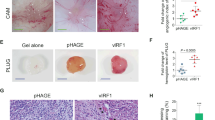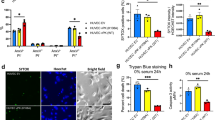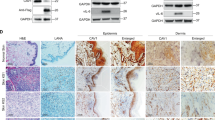Abstract
Human herpesvirus 8 (HHV8), also known as Kaposi's sarcoma-associated herpesvirus, is linked to the development of Kaposi's sarcoma, a disease characterized by the presence of distinctive proliferating spindle-like cells. Although HHV8 can induce spindle cell transformation of vascular endothelial cells in vitro, the viral gene(s) responsible for this phenotype remain to be identified. We demonstrate that expression of HHV8-encoded viral Fas-associated death domain protein-like IL-1β-converting enzyme inhibitory protein K13 is sufficient to induce spindle cell phenotype in human umbilical vein endothelial cells (HUVEC), which is associated with the activation of the nuclear factor-κB (NF-κB) pathway and can be blocked by Bay-11-7082, a specific inhibitor of this pathway. K13 induces the expression of several genes known to be upregulated in HHV8-transformed vascular endothelial cells, such as interleukin (IL)-6, IL-8, CXC ligand 3 (CXCL3), orphan G protein coupled receptor (RDC1), cyclooxygenase-2 (COX-2) and dual-specificity phosphatase 5 (DUSP5). Furthermore, similar to K13, HHV8-induced spindle cell transformation of HUVEC is associated with NF-κB activation and can be blocked by Bay-11-7082. Thus, ectopic expression of a single latent gene of HHV8 is sufficient for the acquisition of spindle cell phenotype by vascular endothelial cells and NF-κB activation plays an essential role in this process.
This is a preview of subscription content, access via your institution
Access options
Subscribe to this journal
Receive 50 print issues and online access
$259.00 per year
only $5.18 per issue
Buy this article
- Purchase on Springer Link
- Instant access to full article PDF
Prices may be subject to local taxes which are calculated during checkout




Similar content being viewed by others
References
An J, Sun Y, Sun R, Rettig MB . (2003). Kaposi's sarcoma-associated herpesvirus encoded vFLIP induces cellular IL-6 expression: the role of the NF-kappaB and JNK/AP1 pathways. Oncogene 22: 3371–3385.
Beckstead JH, Wood GS, Fletcher V . (1985). Evidence for the origin of Kaposi's sarcoma from lymphatic endothelium. Am J Pathol 119: 294–300.
Bertin J, Armstrong RC, Ottilie S, Martin DA, Wang Y, Banks S et al. (1997). Death effector domain-containing herpesvirus and poxvirus proteins inhibit both Fas- and TNFR1-induced apoptosis. Proc Natl Acad Sci USA 94: 1172–1176.
Chaudhary PM, Jasmin A, Eby MT, Hood L . (1999). Modulation of the NF-kappa B pathway by virally encoded death effector domains-containing proteins. Oncogene 18: 5738–5746.
Chugh P, Matta H, Schamus S, Zachariah S, Kumar A, Richardson JA et al. (2005). Constitutive NF-kappaB activation, normal Fas-induced apoptosis, and increased incidence of lymphoma in human herpesvirus 8 K13 transgenic mice. Proc Natl Acad Sci USA 102: 12885–12890.
Ciufo DM, Cannon JS, Poole LJ, Wu FY, Murray P, Ambinder RF et al. (2001). Spindle cell conversion by Kaposi's sarcoma-associated herpesvirus: formation of colonies and plaques with mixed lytic and latent gene expression in infected primary dermal microvascular endothelial cell cultures. J Virol 75: 5614–5626.
Corbeil J, Evans LA, Vasak E, Cooper DA, Penny R . (1991). Culture and properties of cells derived from Kaposi sarcoma. J Immunol 146: 2972–2976.
Ensoli B, Gallo RC . (1995). AIDS-associated Kaposi's sarcoma: a new perspective of its pathogenesis and treatment. Proc Assoc Am Physicians 107: 8–18.
Flore O, Rafii S, Ely S, JJ OL, Hyjek EM, Cesarman E . (1998). Transformation of primary human endothelial cells by Kaposi's sarcoma- associated herpesvirus. Nature 394: 588–592.
Hu S, Vincenz C, Buller M, Dixit VM . (1997). A novel family of viral death effector domain-containing molecules that inhibit both CD-95- and tumor necrosis factor receptor-1-induced apoptosis. J Biol Chem 272: 9621–9624.
Kennedy MM, Cooper K, Howells DD, Picton S, Biddolph S, Lucas SB et al. (1998). Identification of HHV8 in early Kaposi's sarcoma: implications for Kaposi's sarcoma pathogenesis. Mol Pathol 51: 14–20.
Liu L, Eby MT, Rathore N, Sinha SK, Kumar A, Chaudhary PM . (2002). The human herpesvirus 8-encoded viral FLICE inhibitory protein physically associates with and persistently activates the ikappa B kinase complex. J Biol Chem 277: 13745–13751.
Masood R, Cai J, Law R, Gill P . (1993). AIDS-associated Kaposi's sarcoma pathogenesis, clinical features, and treatment. Curr Opin Oncol 5: 831–834.
Matta H, Chaudhary PM . (2004). Activation of alternative NF-kappa B pathway by human herpesvirus 8-encoded Fas-associated death domain-like IL-1 beta-converting enzyme inhibitory protein (vFLIP). Proc Natl Acad Sci USA 101: 9399–9404.
Matta H, Sun Q, Moses G, Chaudhary PM . (2003). Molecular genetic analysis of human herpesvirus 8-encoded viral FLICE inhibitory protein-induced NF-kappaB activation. J Biol Chem 278: 52406–52411.
Moore PS, Chang Y . (2001). Molecular virology of Kaposi's sarcoma-associated herpesvirus. Philos Trans R Soc Lond Ser B 356: 499–516.
Moses AV, Fish KN, Ruhl R, Smith PP, Strussenberg JG, Zhu L et al. (1999). Long-term infection and transformation of dermal microvascular endothelial cells by human herpesvirus 8. J Virol 73: 6892–6902.
Naranatt PP, Krishnan HH, Svojanovsky SR, Bloomer C, Mathur S, Chandran B . (2004). Host gene induction and transcriptional reprogramming in Kaposi's sarcoma-associated herpesvirus (KSHV/HHV-8)-infected endothelial, fibroblast, and B cells: insights into modulation events early during infection. Cancer Res 64: 72–84.
Picard D . (2000). Posttranslational regulation of proteins by fusions to steroid-binding domains. Methods Enzymol 327: 385–401.
Raggo C, Ruhl R, McAllister S, Koon H, Dezube BJ, Fruh K et al. (2005). Novel cellular genes essential for transformation of endothelial cells by Kaposi's sarcoma-associated herpesvirus. Cancer Res 65: 5084–5095.
Sturzl M, Hohenadl C, Zietz C, Castanos-Velez E, Wunderlich A, Ascherl G et al. (1999). Expression of K13/v-FLIP gene of human herpesvirus 8 and apoptosis in Kaposi's sarcoma spindle cells. J Natl Cancer Inst 91: 1725–1733.
Sun Q, Matta H, Chaudhary PM . (2003a). The human herpesvirus 8-encoded viral FLICE inhibitory protein protects against growth factor withdrawal-induced apoptosis via NF-kappa B activation. Blood 101: 1956–1961.
Sun Q, Matta H, Lu G, Chaudhary PM . (2006). Induction of IL-8 expression by human herpesvirus 8 encoded vFLIP K13 via NF-kappaB activation. Oncogene 25: 2717–2726.
Sun Q, Zachariah S, Chaudhary PM . (2003b). The human herpesvirus 8-encoded viral FLICE-inhibitory protein induces cellular transformation via NF-kappaB activation. J Biol Chem 278: 52437–52445.
Thome M, Schneider P, Hofmann K, Fickenscher H, Meinl E, Neipel F et al. (1997). Viral FLICE-inhibitory proteins (FLIPs) prevent apoptosis induced by death receptors. Nature 386: 517–521.
Acknowledgements
This work was supported by grants from the National Institutes of Health (CA85177) and the Mario Lemieux Foundation.
Author information
Authors and Affiliations
Corresponding author
Rights and permissions
About this article
Cite this article
Matta, H., Surabhi, R., Zhao, J. et al. Induction of spindle cell morphology in human vascular endothelial cells by human herpesvirus 8-encoded viral FLICE inhibitory protein K13. Oncogene 26, 1656–1660 (2007). https://doi.org/10.1038/sj.onc.1209931
Received:
Revised:
Accepted:
Published:
Issue Date:
DOI: https://doi.org/10.1038/sj.onc.1209931
Keywords
This article is cited by
-
Kaposi's sarcoma-associated herpesvirus-encoded viral FLICE inhibitory protein (vFLIP) K13 suppresses CXCR4 expression by upregulating miR-146a
Oncogene (2010)
-
Integrated microarray and multiplex cytokine analyses of Kaposi's Sarcoma Associated Herpesvirus viral FLICE Inhibitory Protein K13 affected genes and cytokines in human blood vascular endothelial cells
BMC Medical Genomics (2009)
-
A nuclear role for Kaposi's sarcoma-associated herpesvirus-encoded K13 protein in gene regulation
Oncogene (2008)
-
Cross-regulation between herpesviruses and the TNF superfamily members
Nature Reviews Immunology (2008)



